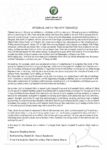An Eye on Adolescence

Adolescence is a transitional stage in human life that spans between childhood and youth. This stage is characterized by developmental changes and various issues that adolescents encounter.
Biologically, biologists define adolescence as a period of life between the onset of puberty and the cessation of physical growth, i.e., reaching maturity leading to sexual reproduction.
Socially, adolescence is a transition from being a child completely dependent on others to becoming an independent, self-sufficient adult.
Psychologically, adolescence is a period in life confined between the end of childhood and the beginning of maturity in the psychological framework. It is characterized by the emergence of the sexual instinct and a preference for independence.
It can be said that adolescence is a complex and crucial stage in human life that requires a lot of support and guidance. During adolescence, the brain undergoes significant developments and changes, including:
- Cognitive and emotional development, as adolescents experience intense emotional fluctuations.
- Brain reorganization, which undergoes a phase of reorganization with synaptic pruning and changes in neural connectivity.
- Neuroplasticity, which leads to enhanced thinking capabilities becoming more complex
- Fluctuations in neurotransmitters and hormones through physiological and psychological processes associated with maturation, as many adolescents experience greater fluctuations in neurotransmitters and hormones such as serotonin, GABA, and cortisol, which can alter their mood.
- Increased activity in the ventromedial prefrontal cortex, which is involved in processing and responding to other people.
- Increased sensitivity towards others’ opinions, as research shows that activity in brain areas related to self-evaluation tends to peak during mid-adolescence, making them particularly sensitive to insults, which increases their exposure to social anxiety.
These changes contribute to the development of adolescents’ mental and emotional capabilities, helping them adapt to new challenges they face during this important life stage.
Social Media Factor:
The use of social media has multiple effects on the brain and mental health of adolescents, thus affecting their choices and decisions. Notable effects include:
- Enhancing serotonin and other chemicals that induce feelings of satisfaction in the brain.
- Better development of social skills through the use of social media.
- Impact on mental health, as intense social media use is linked to negative self-esteem and well-being, with many adolescents experiencing feelings of depression and despair.
- Changes in brain development, with a referenced study showing that long-term social media use is associated with changes in brain development during adolescents’ growth.
- Impact on well-being and self-esteem, as the mental health of girls declines more after age 14, affecting both genders.
- Impact on mental health and physical activity for both genders.
It’s worth noting that the effects of social media on mental health depend on multiple factors, including the content viewed by the adolescent, the activities they engage in online, the amount of time spent online, and psychological factors such as maturity level, pre-existing mental health conditions, and personal life circumstances, including cultural, social, and economic factors.
Excessive use of social media can lead to several harms and negatives, including:
- Impact on mental health, as excessive use can lead to mental health issues such as depression and anxiety.
- Impact on academic performance.
- Impact on physical health such as sleep and eating disorders.
- Excessive use can lead to social isolation and introversion.
- Impact on values and traditions, which manifest in non-compliance with community norms and traditions.
- Increase in cybercrimes such as extortion.
- Impact on self-esteem through feelings of inferiority.
According to experts, there are several ways to reduce the negative impact of social media on adolescents, including: - Setting reasonable boundaries, including discussing with adolescents how to avoid social media interference in their activities, sleep, meals, or school duties.
- Monitoring adolescent accounts and regularly checking their social media accounts.
- Explaining inappropriate matters, clarifying what might be inappropriate or harmful on social media.
- Encouraging direct contact with friends rather than heavily relying on social media.
- Discussing social media through open dialogue about its safe and responsible use.
- Distinguishing misinformation and misleading information.
- Avoiding social comparisons between themselves and others on social media.
Extremist and Criminal Thought and Adolescence:
During this age stage, adolescents may be more susceptible to the negative influences of extremist or criminal thought, being seen as a dark and bleak influence even if they are not similar. It’s essential to alert to some reasons that may make adolescents more susceptible to the influence of extremist or criminal thought, including:
- Searching for identity in adolescence, which may attract them to extremist and criminal thought as it provides them with a clear identity and a set of values and beliefs.
- The desire for rebellion, as adolescence is a stage of life where young people tend to rebel and challenge, and dark thought may attract them as a form of rebellion against authority and society.
- The desire for belonging, as young people in adolescence search for belonging and acceptance, and dark thought may also attract them as it offers them a clear community to belong to.
- Social and psychological pressures, as adolescents face many social and psychological pressures, including school pressure and peer pressure.
- External influences, which they can be significantly influenced by, including the media and peers, as they may be influenced by dark thought if exposed to it through these channels.
Prevention and Treatment:
The saying goes, “An ounce of prevention is better than a pound of cure,” but combining prevention and treatment in one approach is even more beneficial. In this article, I try to provide some tips that can help prevent the effects of dark thought on adolescents, based on our curriculum and vision in the Syrian Future Stream:
- Rebuilding and reorganizing the individual, intellectually and culturally, as well as instilling correct concepts inside the adolescent and caring for each individual socially.
- Increasing intellectual, social, and political awareness among adolescents, as well as establishing principles of democratic dialogue and respect for others’ opinions.
- Improving the economic level in the country, providing job opportunities, and establishing investment projects for the benefit of the youth, so they do not feel at the beginning of their lives that their economic and social status is blocked.
- Giving significant importance to student unions in schools and also in universities, and conducting activities to educate individuals politically.
- Paying attention to what visual, auditory, and written media offer, and working to correct and repair media content that negatively affects adolescents.
As we in the Syrian Future Movement emphasize, education plays a crucial role in preventing adolescents’ attraction to crime, addiction, and extremism in all its forms.
Education can provide awareness programs about the harms associated with crime and addiction, and these programs can include information about the health, social, and legal damages of these actions. Education can also help enhance life skills such as critical thinking, decision-making, and stress management.
These skills can help adolescents face challenges and avoid harmful behaviors. Schools and teachers can offer psychological support to students facing difficulties. This support can include counseling and referrals to professional support services. Education can also help enhance adolescents’ feelings of belonging and acceptance and prevent feelings of isolation and marginalization, which can lead to crime, addiction, and extremism.
Finally, we recommend in the Office of Family Affairs at the Syrian Future Movement the following:
- Actively listen to the adolescent and interact in a way that enhances trust and mutual respect.
- Visual contact as an effective tool for communicating with adolescents.
- Openness by parents and teachers to be honest with adolescents.
- Avoid crushing the adolescent’s feelings through avoiding negative comments that may crush their feelings.
- Listen to the adolescent’s opinion and respect it.
- Avoid contradicting words and actions by parents and teachers.
- Focus on the positives, no matter how small, and avoid focusing on the negatives and exaggerating them and comparing the adolescent with other adolescents.
- Make the adolescent feel loved and cared for, but this should be done moderately away from exaggeration to help them bear responsibility and increase their resilience.
- Respect the adolescent’s friends and honor them.
- Present gifts to the adolescent from time to time.
Finally, it’s worth noting that parents and teachers play a crucial role in guiding adolescents on how to use social media safely and responsibly, monitoring them, and moving forward with them to overcome this dangerous and formative age stage, as adolescence is a sensitive and formative stage in human life.
Wheeba Al-Masri
Family Affairs Office
Research and Studies Department
Studies
Syrian Future Movement (SFM)
References:
- The Psychology of Adolescence: Theories, Growth Aspects, Problems, and Solutions. Link.
- Adolescence: Concept, Definition, Types, Characteristics, and Theories. Link.
- [PDF] Definition and Classification of Adolescence. Link.
- From Childhood to Adulthood: The Amazing Journey of the Adolescent Brain. Link.
- Brain Changes During Adolescence – Frontiers for Young Minds. Link.
- e3arabi – Psychological Changes During Adolescence. Link.
- Top 6 Psychological Changes During Adolescence – Al Gooru. Link.
- How to Help Your Teen Navigate Social Media. Link.
- Social Media: How Does It “Harm” Teen Mental Health? Link.
- Teen Use of Social Media “Increases Feelings of Frustration.” Link.
- How Does Social Media Addiction Affect the Adolescent Brain? Link.
- The Impact of Social Media on Teen Mental Health. Link.
- Youth and Extremism – Reasons for Joining Violent Extremist Groups. Link.
- How Does a Radical Think? – BBC News Arabic. Link.
- What Are the Most Important Crises Faced by Adolescents and How Do Parents Deal With Them? Link.
- The Impact of Adolescents’ Exposure to YouTube Content Related to Extremism. Link.
- How Does Intellectual Security Protect Youth From Extremism? | Al Rai Newspaper. Link.
- Addiction in Adolescents – Aanab. Link.
- Addiction in Adolescents and Protecting Them From Addiction. [Link]






